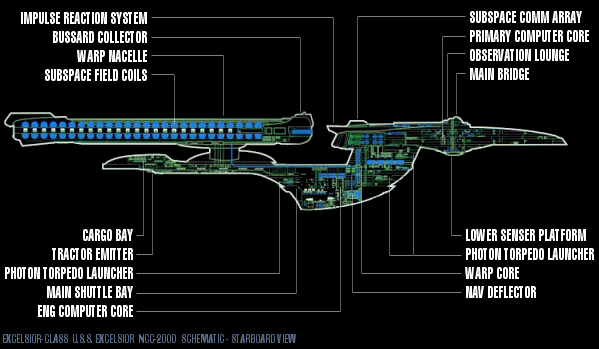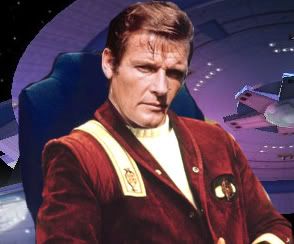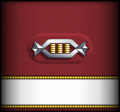Post by Captain Alexander Kynes on Jan 7, 2007 3:11:34 GMT

Excelsior Class
Affilation: United Federation of Planets
Length Overall 467.0 m (1532.2 ft)
Width Overall 181.6 m (595.8 ft)
Height Overall 77.8 m (255.4 ft)
Nacelle Length 248.6 m (815.7 ft)
Engineering Hull Length 263.8 m (865.4 ft)
Primary Propulsion Twin Warp Drive Nacelles
Secondary Propulsion Twin Impulse Engines
Cruising Speed: Warp Factor 10* (1000c)
Max Safe Speed: Warp Factor 12* (1728c)
Number of Decks: 18
Crew Complement: 510
Defense: Deflector Shields
Armament:
12 Phaser banks,
4 photon torpedo Launch Tubes
Despite the problems with the original design of the Excelsior class, Starfleet was still content with the existing space frame, ordering the construction of a large number of additional Excelsior vessels over the coming decades.
The original Excelsior was modified after its prototype run in accordance with its new propulsion scheme. Several years later, a new variant added modifications to the basic hull design. One ship of this modified sub-class was the USS Enterprise NCC-1701-B. Later ships continued to incorporate the latest technology while returing to the original hull form.
Many Excelsiors seen in TNG and later series have high registry numbers concurrent with the ships being built decades after the prototype but share its basic design. A series of this vessel were equipped with dilithium recompositing and recrystalization technology. However, the theta-matrix compositor used in later Galaxy-class ships makes the recrystallization process ten times more efficient than the Excelsior-class.
The Excelsior fires photon torpedoesThe original Excelsior was outfitted with 12 dual phaser emplacements and four photon torpedo launchers.
As the ships were built over a very long period of time, the power and capabilities of the weapon emplacements increased. This included the installation of faster firing torpedo tubes and more powerful and accurate phaser banks. Additionally, many earlier ships were refit with newer weapons during their scheduled major refit and overhaul period keeping them in front line service.
In the 2370s, some Excelsiors like the USS Lakota were outfitted with additional phaser emplacements, quantum torpedoes, and other improvements to make the ship competitive with later designs. All of these modifications were made using existing ports; from the external appearance of the vessel there are few physical modifications visible.
Located on top of the primary hull, the Excelsior Main Bridge directly supervises all primary mission operations and coordindates all departmental activities. Due to the age and variety of configurations of the Excelsior-class, bridge configurations can vary from ship to ship.
Against the aft wall of many Excelsior bridges is the large engineering master systems display monitor, showing a cutaway of the ship and status information. This was not originally part of the USS Excelsior configuration but added later, a feature shared with sister ship USS Enterprise-B.
Senior officers, such as the captain, had private quarters belowdecks. Many of the enlisted crew and junior officers shared quarters and bunk areas.
The Excelsior-class' shuttlebay is located on the dorsal stern of the secondary hull, and houses several shuttles of different types, including type-7 shuttlecraft. There is also a large cargo hangar in the lower decks of the secondary hull.
USS Berlin (NCC-14232)
USS Cairo (NCC-42136)
USS Charleston (NCC-42285)
USS Crazy Horse (NCC-50446)
USS Enterprise (modified, NCC-1701-B)
USS Endeavour (NCC-1718-B)
USS Excelsior (prototype, NX-2000/NCC-2000)
USS Farragut
USS Fearless (NCC-14598)
USS Fredrickson (NCC-42111)
USS Gorkon (NCC-40512)
USS Hood
USS Intrepid (NCC-38907)
USS Lakota (modified, NCC-42768)
USS Malinche (NCC-38997)
USS Melbourne (NCC-62043)
USS Potemkin (NCC-18253)
USS Repulse (NCC-2544)
USS Valley Forge (NCC-43305)
 Captain
Captain
